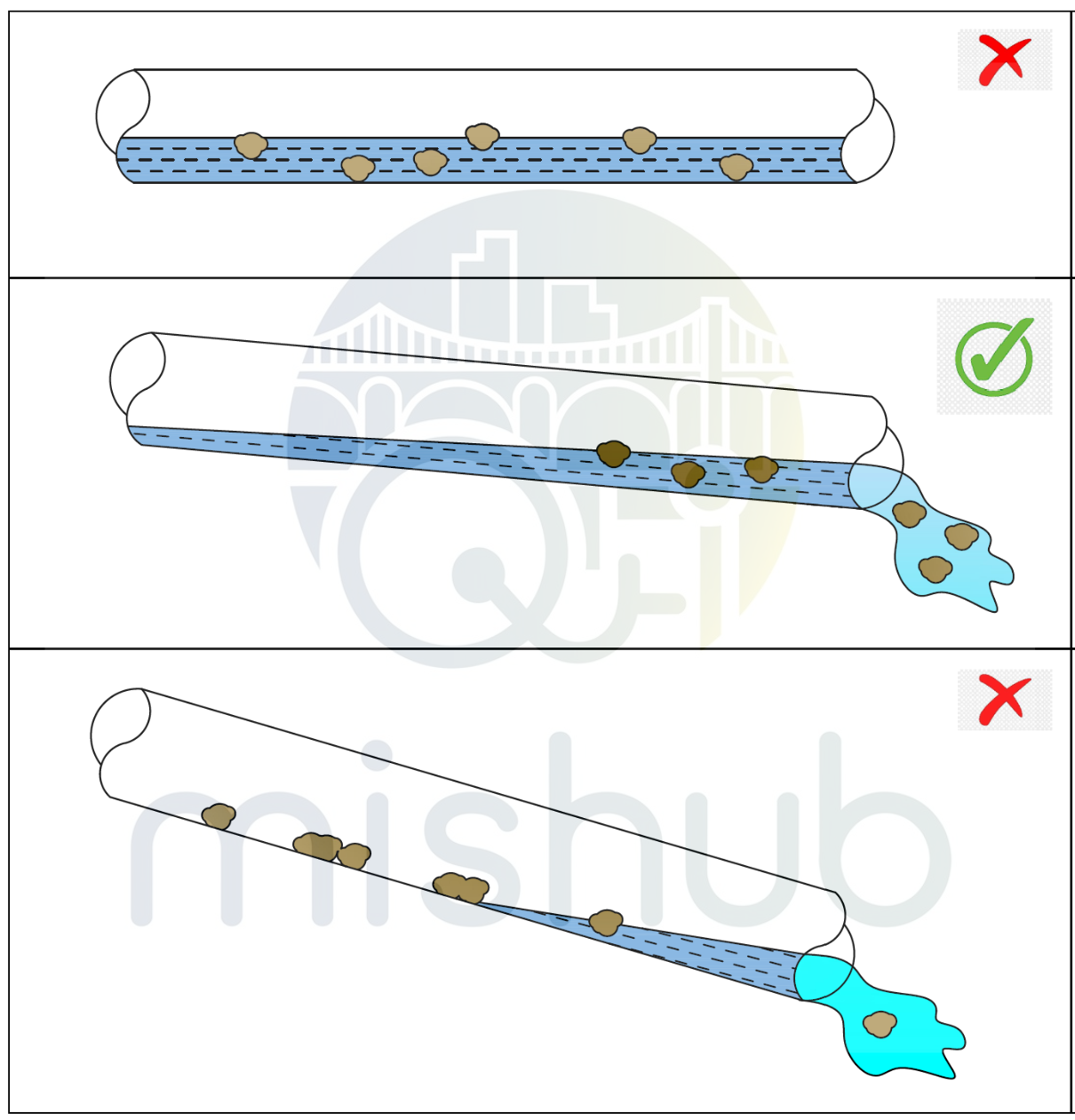MISHub QI
Proper Slope in Wastewater Drainage Systems
Proper Slope in Wastewater Drainage Systems
The slope of pipes in wastewater drainage systems is a critical parameter that directly influences the efficiency of effluent transport, preventing blockages, solid deposition and network malfunction. This study addresses European technical standards, sizing recommendations and design criteria, based on bibliographical references and consolidated studies.
2. Relevant European Technical Standards
2.1. EN 12056: Gravity drainage systems inside buildings
EN 12056 establishes the principles for dimensioning gravity drainage systems, including minimum and maximum slopes for different pipe diameters.
- Horizontal pipes (branches and collectors):
- Diameter DN 50 to DN 100 : Minimum slope of 2% (20 mm/m) .
- Diameter DN 125 to DN 150 : Minimum slope of 1% (10 mm/m) .
- Diameter ≥ DN 200 : Minimum slope of 0.5% (5 mm/m) .
Source: EN 12056-2:2000 - Gravity drainage systems inside buildings - Part 2: Sanitary pipework, layout and calculation
2.2. EN 752: Drainage systems on the exterior of buildings
The EN 752 standard regulates the dimensioning of external drainage networks, including slope criteria to avoid sedimentation and ensure self-cleaning.
- Recommended minimum slope:
- DN 150 to DN 300 : 0.5% to 1% (5 to 10 mm/m).
- DN > 300 : Can be reduced to 0.3% (3 mm/m) if justified by hydraulic calculations.
Source: EN 752:2017 - Drain and sewer systems outside buildings
3. Technical Fundamentals of Slope in Drainage Systems
3.1. Self-Cleaning Speed
To avoid deposition of solids, the flow velocity must be sufficient to transport particles. EN 752 recommends:
- Minimum speed: 0.7 m/s (under minimum flow conditions).
- Maximum speed: 2.5 m/s (to avoid erosion and excessive noise).
3.2. Equation of Manning-Strickler
The slope ( S ) can be calculated using Manning's formula:

Reference: Chow, V. T. (1959) - Open-Channel Hydraulics
Practical Example:
Manning-Strickler Equation (Formulation for Calculating Slope)

Rearranging to calculate slope (S):

- Determine the required slope for a DN 150 pipe (0.15 m internal diameter) in PVC, ensuring a minimum self-cleaning speed of 0.7 m/s.
Input Data:
- Inner diameter (D): 0.15 m (full circular tube)
- Desired speed (v): 0.7 m/s
- Roughness coefficient (n): 0.009 (PVC)
- Hydraulic Radius (R): For full circular tube, R = D/4 = 0.15/4 = 0.0375m
Apply the Rearranged Manning Equation

Convert to Percentage
S(%) = 0.0031 × 100 ≈ 0.31%
Result and Analysis:
- Calculated slope: 0.31% (≈ 3.1 mm/m ).
- Comparison with standards:
- EN 12056 recommends 1% (10 mm/m) for DN 150.
Justification for Adjustment:
- Margin of Safety:
- The theoretical calculation assumes continuous and full flow, but in practice, flow rates vary.
- Example: If the flow rate decreases by 50%, the velocity would drop to ~0.35 m/s (< 0.7 m/s), increasing the risk of sedimentation.
- Revised Formula with Safety Factor (k = 1.5)

- Even with this factor, we still have Smin below 1%. Therefore, the Standard prevails .
Calculation Summary Table
Speed calculated with Smin = 1%:

(Within the maximum limit of 2.5 m/s).
|
Parameter |
Theoretical Value |
Normative Value (EN 12056) |
|
Slope (S) |
0.31% |
1% |
|
Resulting velocity |
0.7 m/s |
~1.3 m/s |
|
Adaptation to DN 150 |
Insufficient |
According to |
Final Recommendations
- Use 1% slope , even if the theoretical calculation allows less.
- If possible, test with real flow (e.g. simulation in software such as EPANET).
- In short sections (< 1 m), slopes of up to 0.5% are accepted if justified by the project.
Normative Source:
- EN 12056-2:2000 (§4.2.2): "Slopes of less than 1% are only permitted if self-cleaning is proven."
Note:
-
Why is the calculated value lower than the norm? The Manning-Strickler equation assumes ideal conditions (uniform flow, full circular tube, etc.). In practice, it is common to increase the slope to compensate:
- Flow variations (e.g. periods of low flow).
- Presence of solids (sand, fats, among others).
-
Simplified formula for quick projects:
For waste water pipes (PVC, n ≈ 0.009), with a minimum permissible speed according to EN 752 (v = 0.7 m/s) and considering the hydraulic radius for a full circular pipe (R = D/4), we will have:

Where:
S min - Minimum slope;
D - Internal diameter.
4. Comparative Studies and Practical Recommendations
4.1. Recommendations from the EPA (Environmental Protection Agency, USA)
Although not a European standard, report EPA/600/2-88/001 reinforces the importance of adequate slopes, suggesting:
- Absolute minimum: 0.4% (4 mm/m) for large diameter pipes.
- Ideal: 1% to 2% for residential pipes.
Source: EPA (1988) - Design Manual: Sewerage and Wastewater Systems
Bibliographic References:
EN 12056-2:2000 - Gravity drainage systems inside buildings .
EN 752:2017 - Drain and sewer systems outside buildings .
Chow, VT (1959) - Open-Channel Hydraulics .
EPA (1988) - Design Manual: Sewerage and Wastewater Systems .
Author: Eng. Francisco Quisele Jr.
Date of publication : 03/30/25
Share


